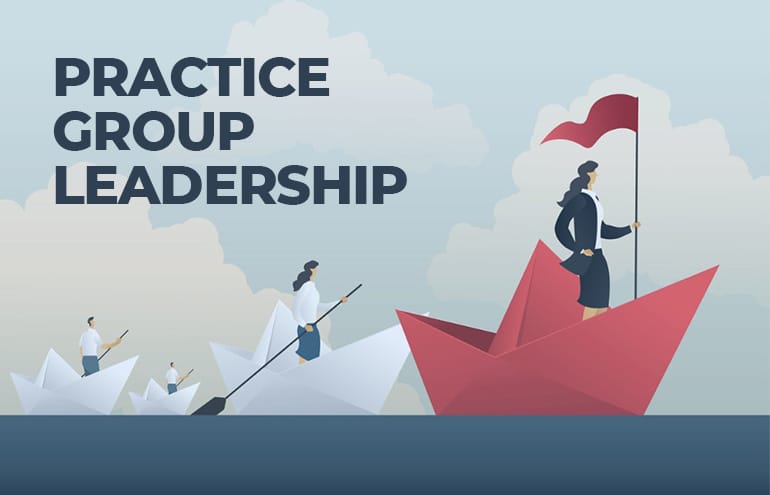A law firm’s practice group leaders (PGLs) are the bridge between firm leadership and the individual lawyers within their practice groups. Succeeding in this multifaceted role requires a blend of leadership and practical management skills, both on the business side and the people side. Here is an overview of key leadership development areas to focus on and the four main roles a PGL fulfills for the firm.

Table of contents
Essential Skills for Practice Group Leaders
Building a Strong Personal Foundation
Effective leadership hinges on a strong personal foundation. To lead others effectively, as a PGL you must first invest in your own leadership development. This starts with self-awareness. Understanding your strengths, values, motivators, triggers, blind spots, biases (we all have them!) and opportunities for development allows for more conscious decision-making and fosters trust with team members.
Ideally, you are already continuously investing in your own leadership development, for example, by working with an executive coach. At a minimum, you’ll have taken an assessment to get a deeper understanding of your innate strengths and limitations. The DiSC Personality and Management Profile and DiSC Work of Leaders assessments are excellent for helping get a deeper understanding of your leadership style. This helps you learn how to play to your strengths to maximize your impact in ways that feel natural and authentic.
Building Influence and Getting Results
Beyond personal leadership development, to be effective, you must develop a robust set of leadership skills to propel your group forward.
- Executive presence — the ability to project confidence, strengthen credibility and inspire trust—is paramount when interacting with partners, clients and potential candidates.
- Adeptly handling difficult conversations and managing conflict is crucial for navigating disagreements and fostering a collaborative environment. PGLs must equip themselves with the skills to address performance issues and hold team members accountable with empathy and fairness.
- Lastly, building strong networks and relationships is essential. PGLs who cultivate connections with partners across different practice groups, firm and industry leaders, and current and future clients position themselves and their group for success by fostering collaboration, innovation and new business opportunities.
The Four Hats of Practice Group Leaders
Practice group leaders wear many hats, but the four main roles you assume are strategic architect, financial steward, operational leader and talent developer.
1. Chief Strategy Officer
In this role, you are responsible for developing a clear and actionable strategy for the group. This strategy must align with the overall firm’s vision and the national practice group’s goals (if applicable). Setting clear goals and developing a robust execution plan provides a road map to ensure everyone works toward the same goals. (For more concrete strategic planning ideas, see Future-proofing Your Practice Group.) Tough decisions often involve making trade-offs, such as identifying areas where resources can be reallocated to maximize productivity or profitability. Communicating the strategy effectively to all partners and group members is vital for achieving buy-in and fostering a sense of shared purpose.
2. Chief Finance Officer
Financial acumen is also critical for PGLs. You should be adept at budget planning, interpreting financial statements, and establishing clear metrics for measuring productivity and profitability. Understanding firm financials will allow you to make informed decisions about resource allocation, track performance, and identify areas for improvement.
3. Chief Operations Officer
In this role, you are responsible for the smooth day-to-day functioning of the practice group. This includes strategic resource allocation — basically, making sure the right people have the right tools and support to excel. Top performers may require additional resources or accommodations. Work allocation becomes a crucial function, balancing workload distribution with individual strengths and expertise.
You must also be prepared to run effective meetings that focus on clear agendas, foster participation, and achieve concrete outcomes.
4. Chief Talent Officer
This is perhaps your most crucial role as a practice group leader. Motivating, engaging, developing and retaining talent within the practice group is essential for its long-term success. As a PGL, you play a vital role in shaping the group’s culture and setting expectations for behavior and interactions. You must also be adept at managing diverse personalities while fostering a culture of inclusion and respect where everyone feels valued and heard. Adding coaching skills to your toolbelt is key to being able to help your lawyers identify their strengths and opportunities for development, set goals and grow their skills.
The Power of Effective Practice Group Leadership
Effective PGLs wear many hats, demanding a unique blend of leadership skills and practical knowledge. By investing in leadership development, honing essential management skills, and embracing these multifaceted roles, you can build a thriving practice group that delivers exceptional client service and drives long-term success for the firm.
Image © iStockPhoto.com.

Sign up for Attorney at Work’s daily practice tips newsletter here and subscribe to our podcast, Attorney at Work Today.
















